Beijing Olympic Park is located in Chaoyang District, Beijing, at the northern end of Beijing's Central Axis. It stretches south to North Tucheng East Road, north to the southern bank of the Qinghe River, west to Baimiaocun Road, and east to Anli Road. As a national 5A-level tourist attraction, it covers a total area of approximately 11.59 square kilometers, among which Olympic Forest Park accounts for about 680 hectares, the central area about 315 hectares, and the Dragon-shaped Water System about 226 hectares. Centered on the sports venues of the 2008 Beijing Olympic Games and the 2022 Beijing Winter Olympic Games, the scenic area integrates multiple functions such as sports events, cultural exhibitions, leisure and entertainment, and ecological landscapes. It is a comprehensive urban area combining modern architecture, natural landscapes, and humanistic history. The scenic area is home to iconic buildings including the Bird's Nest (National Stadium), the Water Cube (National Aquatics Center), and the National Indoor Stadium, as well as large-scale ecological landscapes like Olympic Forest Park, making it an important cultural and sports landmark in Beijing and even across the country.
History and Culture
The construction of Beijing Olympic Park started after Beijing successfully bid for the Olympic Games in 2001. As the main venue of the 29th Summer Olympic Games in 2008, it hosted important events such as the opening and closing ceremonies, athletics, and swimming competitions. After the 2008 Olympic Games, the park was planned for post-games use, opening its sports venues and public spaces to the public, and evolving into an urban functional area integrating sports, culture, and leisure. In 2015, Beijing successfully won the bid for the 24th Winter Olympic Games in 2022, and Olympic Park once again became the core area of the Winter Olympics. The Water Cube was transformed into the "Ice Cube" to host curling competitions, and the Bird's Nest hosted the opening and closing ceremonies of the Winter Olympics again, demonstrating the unique charm of being a "dual-Olympic venue".
The design concept of the park integrates traditional Chinese culture with modern technology. The extension of the Central Axis and the layout of the Dragon-shaped Water System embody the inheritance of traditional urban planning concepts, while the modern architectural style and intelligent facilities of the venues showcase the progress of science and technology. In addition, a large number of Olympic cultural sculptures and Olympic torch displays are set up in the park, recording the history and spirit of the Olympic Games, and serving as an important carrier for the inheritance of Olympic culture.
Major Attractions
The Bird's Nest
Located in the southern part of the central area of Olympic Park, it was the venue for the opening and closing ceremonies and athletics competitions of the 2008 Beijing Olympic Games, as well as the opening and closing ceremonies of the 2022 Beijing Winter Olympic Games. With a construction area of 258,000 square meters, it can accommodate 91,000 spectators. Featuring a unique architectural design woven from massive steel structures, it resembles a bird's nest and is a masterpiece of modern architecture. After the games, it serves as a venue for large-scale performances and sports events, and is also open to tourists for visits.
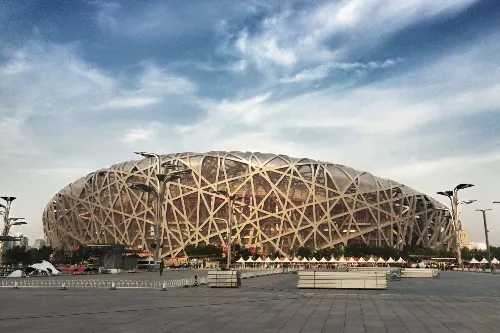
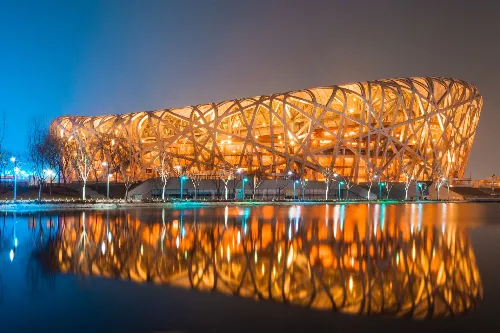
The Water Cube
Located to the west of the Bird's Nest, it was the venue for swimming and diving competitions of the 2008 Olympic Games. With a construction area of 80,000 square meters, it can seat 17,000 spectators. Its exterior is made of ETFE membrane structures, looking like a blue water bubble. During the 2022 Winter Olympics, it was converted into the "Ice Cube" through the "water-to-ice conversion" technology to host curling events. After the games, it is open to tourists for water activities such as swimming and water play, as well as curling experience programs.
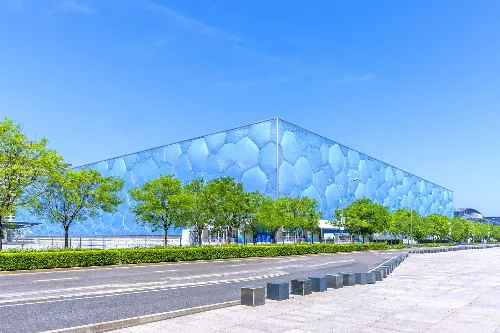

Olympic Forest Park
Located in the northern part of Olympic Park, covering an area of about 680 hectares, it is one of the largest urban parks in Beijing. The park is divided into the South Garden and the North Garden, with the South Garden covering about 380 hectares and the North Garden about 300 hectares. It boasts natural landscapes such as the Ao Sea and Yangshan Mountain, as well as ecological areas including ecological corridors and forest wetlands, making it an ideal place for citizens to relax, exercise, and get close to nature. The park has a number of walking trails and cycling paths, among which the plastic track in the South Garden is about 5 kilometers long.
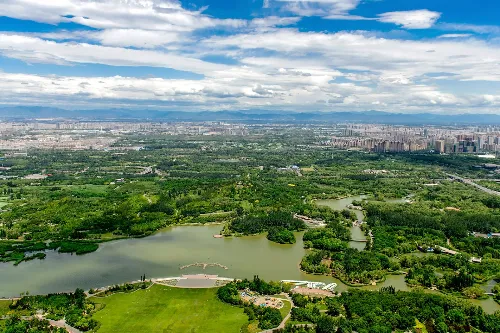
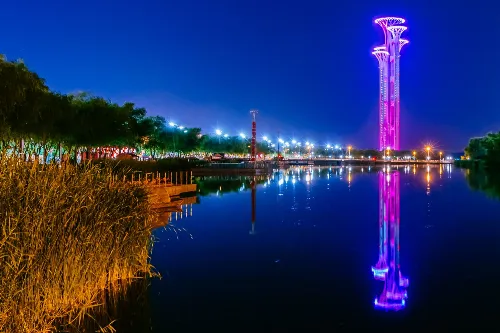
National Indoor Stadium
Located to the north of the Bird's Nest, it was the venue for gymnastics and trampoline competitions of the 2008 Olympic Games. With a construction area of 80,800 square meters, it can hold 18,000 spectators. Featuring a concise and elegant architectural style, it has been used to host various sports events, cultural performances, and large-scale activities after the games, such as figure skating and short-track speed skating competitions.

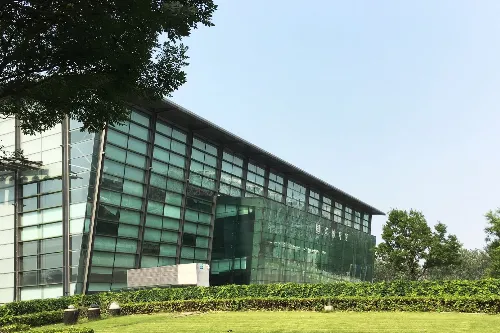
Dragon-shaped Water System
Running through the central area of Olympic Park, it stretches about 2.7 kilometers with a water surface area of approximately 16.5 hectares. Extending from south to north and intersecting with the Central Axis, the water system forms a "dragon" shape, embodying the image of the dragon in traditional Chinese culture. Walking paths and landscape belts are built on both sides of the water system, making it a perfect place for tourists to take a walk and enjoy the scenery.
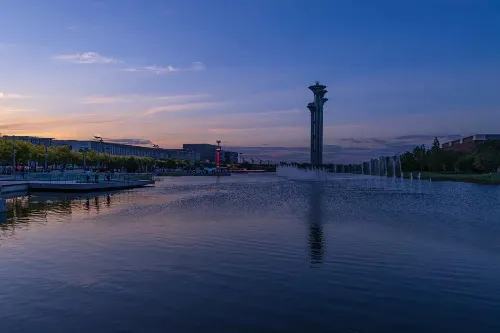
Olympic Manifesto Square
Located in the central area of Olympic Park, it is a cultural square built to commemorate the release of the Olympic Manifesto. A bronze relief of the Olympic Manifesto stands in the square, surrounded by Olympic-themed sculptures and landscapes, serving as an important place for spreading the Olympic spirit.
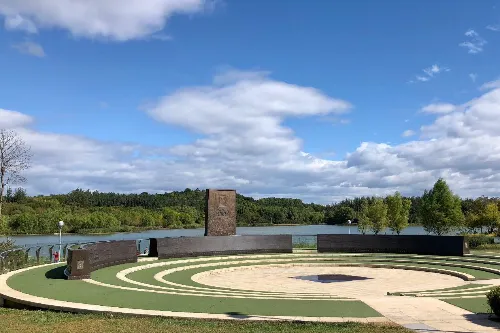
Recommended Tour Routes
Half-day Tour Route: Enter through the South Gate of Olympic Park → The Bird's Nest → The Water Cube → Stroll along the Dragon-shaped Water System → Olympic Manifesto Square → Exterior view of the National Indoor Stadium → Exit through the North Gate of the central area and head to the South Garden of Olympic Forest Park to visit scenic spots like the Ao Sea and Yangshan Mountain. The whole walk takes about 2-3 hours.
One-day Tour Route: Visit the South Garden of Olympic Forest Park in the morning, enter through the South Gate, walk along the Ao Sea to Yangshan Mountain, climb to the top to overlook the panoramic view of the park, and then exit through the North Gate; taste Beijing's local delicacies nearby at noon; go to the central area in the afternoon to visit the Bird's Nest and the Water Cube, and you can enter the venues to learn about the Olympic history and architectural features; take a walk by the Dragon-shaped Water System in the evening to enjoy the sunset scenery; if there are performances or events at night, you can watch the night shows at the Bird's Nest or the Water Cube. The whole tour takes about 5-6 hours.
Two-day One-night Tour Route: On the first day, visit the South Garden and North Garden of Olympic Forest Park in the morning to experience the forest ecological landscape, and you can choose to cycle or hike; go to the central area in the afternoon to visit venues such as the Bird's Nest, the Water Cube, and the National Indoor Stadium; stay at a hotel near the park at night and enjoy the night view of Olympic Park. On the second day, visit the cultural facilities in Olympic Park in the morning, such as the China Science and Technology Museum (separate ticket required); relax near the Dragon-shaped Water System in the afternoon or participate in interactive experience programs in the scenic area, such as water activities at the Water Cube, and then end the trip.
Travel Tips
- It is recommended to check the opening hours and event schedules of each venue through official channels in advance to avoid being unable to visit upon arrival.
- Olympic Park covers a large area, so it is advisable to wear comfortable shoes. If you need to walk for a long time, you can prepare a lightweight backpack and drinking water.
- Pay attention to sun protection and heatstroke prevention when visiting in summer. There are many trees in Olympic Forest Park, which can provide proper shade; keep warm in winter, especially when visiting outdoor venues.
- If you are interested in Olympic history and architecture, you can rent an electronic audio guide at the venue or join a guided tour organized by the scenic area to learn more about the stories behind the attractions.
- Pets are not allowed in Olympic Forest Park, please abide by the park regulations; smoking is prohibited in some areas of the central area, please follow the relevant rules.
- If you plan to visit multiple venues, you can purchase a combined ticket to save costs; students, the elderly, etc., can enjoy ticket discounts with valid certificates.
Notes
- Comply with the opening hours of the park and do not stay in the park after closing time.
- When visiting the venues, please abide by the venue regulations, such as no flammable and explosive items allowed, no touching the exhibits, etc.
- Do not pick plants or feed animals arbitrarily in Olympic Forest Park to maintain the ecological environment of the park.
- Be careful when walking around the Dragon-shaped Water System, especially for tourists with children, please stay away from the water's edge.
- There are many public toilets and trash cans in the park, please keep the environment clean and do not litter.
- Some areas may be temporarily closed during large-scale events or competitions, please follow the guidance and arrangements of the staff.
- Take good care of your personal belongings, especially in crowded areas, to avoid loss.
- If you need to cycle in the park, please use qualified shared bikes and ride only on designated cycling paths, and pay attention to avoiding pedestrians.
Transportation
- Subway: Take Line 8 and get off at Olympic Sports Center Station, Olympic Park Station, or Forest Park South Gate Station, which can directly reach different areas of the park. Among them, Olympic Park Station leads to the central area, and Forest Park South Gate Station directly reaches the South Garden of Olympic Forest Park.
- Bus: Multiple bus routes are available. For example, take Bus No. 82, 510, or 607 and get off at Beichen West Bridge North Station to reach the central area; take Bus No. 311, 379, or 484 and get off at Olympic Forest Park South Gate Station to reach the South Garden of Olympic Forest Park.
- Self-driving: There are multiple parking lots around the park, such as the National Stadium Parking Lot, Water Cube Parking Lot, and Olympic Forest Park South Garden Parking Lot. The parking fee is about 10-15 yuan per hour. Parking spaces may be tight during peak seasons, so green travel is recommended.
- Shared Bikes: There are shared bike parking spots around the park. Tourists can ride into the designated cycling paths in the park (note that cycling is restricted in some areas, please pay attention to the signs).
Opening Hours
The park is open 24 hours a day, and tourists can enter at any time. The opening hours of Olympic Forest Park are: peak season (March 15 - November 15) 6:00 - 21:00, off-season (November 16 - March 14 of the following year) 6:00 - 20:00. The opening hours of venues such as the Bird's Nest and the Water Cube are usually 9:00 - 19:00 (admission stops at 18:00), and the specific hours may be adjusted according to event arrangements.
Tickets
The park is open to the public free of charge, and tourists can enter and visit freely. However, tickets are required for visiting some venues, such as the Bird's Nest and the Water Cube, and the specific ticket information is subject to the on-site notice of the venues on the day of visit. Special exhibitions or events held in the venues may require additional tickets.
You can search for the official WeChat public account "北京奥林匹克公园" to get the latest updates.
You can search for the official WeChat public account "鸟巢" to purchase tickets for visiting the Bird's Nest.
You can search for the official WeChat public account "水立方" to purchase tickets for visiting the Water Cube.
Online Booking
Click here to jump to the Trip.com ticketing platform for ticket purchase.


